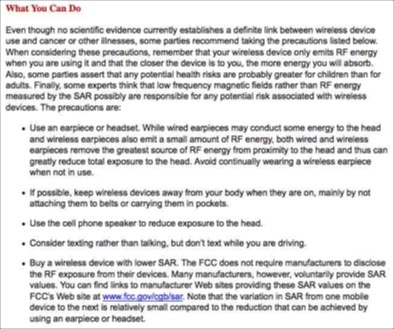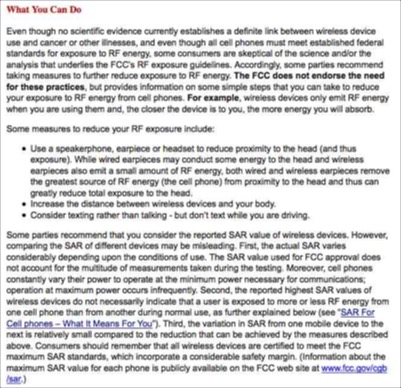FCC/CGB Secretly Flip-flops on Decade Old SAR Policy

This week there were some unannounced odd changes on the FCC’s Consumer & Government Affairs Bureau’s website of consumer publications. The changes consisted of a rewrite of the “Wireless Devices and Health Concerns” FCC Consumer Facts and the creating of a new one entitled “SAR For Cell Phones: What It Means For You”.
It seems likely that these changes were requested off the public record by CTIA to bolster their case for their law suit with San Francisco over SAR disclosure at retail stores that sell cell phones. First the changes.
The old “Wireless Devices and Health Concerns” FCC Consumer Facts has now disappeared from the FCC website, but thanks to Google’s caching feature it could be still be found in cyberspace for a few days after the change. It is shown below and linked to the copy that was lurking in the Google cache:
In the old version FCC advises consumers to consider “buy(ing) a wireless device with lower SAR”. This concept goes back to 2000 and was implemented by Chmn. Kennard after the UK adopted a similar policy. At the same time, over CTIA’s strenuous objections, FCC greatly simplified the access to SAR data on its website. (The data had always been there, but it was nearly impossible to find prior to the Kennard directed change to make it more accessible.)
Here is the new version of the fact sheet. Notice the changes?
The “Recent Developments” section of this fact sheet has no information about any change or justification thereof. The CGB homepage has no mention of this topic.
In the new fact sheet, the phrase “some parties recommend taking the precautions listed below” has been replaced with “even though all cell phones must meet established federal standards for exposure to RF energy, some consumers are skeptical of the science and/or the analysis that underlies the FCC’s RF exposure guidelines.” Perhaps will this secretive manipulation of FCC viewpoints, more consumers will be skeptical.
Most significantly the sentence “Buy a wireless device with lower SAR” has disappeared. Then a new paragraph beginning with “Some parties recommend that you consider the reported SAR value of wireless devices” has been added. Who are those “some parties”? Didn’t they include the FCC a mere week ago? Hasn’t this been the FCC position for a decade? Why the sudden change?
CGB has also created, without fanfare, a whole new fact sheet entitled “SAR For Cell Phones: What It Means For You”.
This new fact sheet has a section What SAR Does Not Show. It tries to fuzzify the SAR data by saying
“The SAR value used for FCC approval does not account for the multitude of measurements taken during the testing. Moreover, cell phones constantly vary their power to operate at the minimum power necessary for communications; operation at maximum power occurs infrequently. Consequently, cell phones cannot be reliably compared for their overall exposure characteristics on the basis of a single SAR value for several reasons (each of these examples is based on a reported SAR value for cell phone A that is higher than that for cell phone B)”
I agree with the statement
For users who are concerned with the adequacy of this standard or who otherwise wish to further reduce their exposure, the most effective means to reduce exposure are to hold the cell phone away from the head or body and to use a speakerphone or hands-free accessory. These measures will generally have much more impact on RF energy absorption than the small difference in SAR between individual cell phones, which, in any event, is an unreliable comparison of RF exposure to consumers, given the variables of individual use.
But the attempt to say SAR doesn’t matter at all is bizarre. While one can not meaningfully compare cell phone model A on AT&T’s network with cell phone model B on T-Mo’s based on SAR data, if you are the customer of a specific cellular carrier it is meaningful to compare the SARs of the phone models they offer - if you use your phone without a Bluetooth and in the held to the head mode.
Now cell phone voice minutes are now actually decreasing and the major growth in traffic is in digital information not using cell phones next to the ear. Unfortunately, the focus in this discussion on the head SAR measurement points out a real anachronism in the FCC process for dealing with SAR measurements in OET Bulletin 65, Supplement C (last revised in 1/01). Rather than secretly tweaking consumer guidance, maybe FCC should revise its SAR measurements to show the numbers that matter with respect to the growing type of cell phone use - Blackberry/iPhone-like handheld web/e-mail use. Note that 47 C.F.R. 2.1093(d)(2) gives an SAR limit of 4 W/kg for hands and wrists (vice 1.6 for rest of the body) so today’s models probably are significantly less than the safety limit in the modes in which they are used most of the time.
Earlier this month the Environmental Working Group filed a Freedom of Information Act request with the FCC seeking any records that might show whether the Commission is working with CTIA to challenge a San Francisco law that requires retailers to display radiation information of mobile devices at the point of sale. Is the above change a sign that EWG is right about FCC working secretly with CTIA? Why the FCC secrecy about this policy flip-flop? If FCC now thinks that SAR level is unimportant except for compliance with the 1.6 W/kg limit -- isn’t that newsworthy enough for the ever cluttered FCC home page?
UPDATE
EWG Blog
EWG: FCC downplays cell phone radiation risks
Washington Post article
cnet.com (Owned by CBS)
“Despite the FCC's revision, and the CTIA's stance that studies show no link between long term cell phone use and an increased cancer risk, the debate is not going away anytime soon. Indeed the scientific evidence remains inconclusive and until we know more, CNET will continue to advise concerned users to choose a phone with a low SAR in our cell phone radiation charts.”
OMB Watch



![Validate my RSS feed [Valid RSS]](valid-rss-rogers.png)

